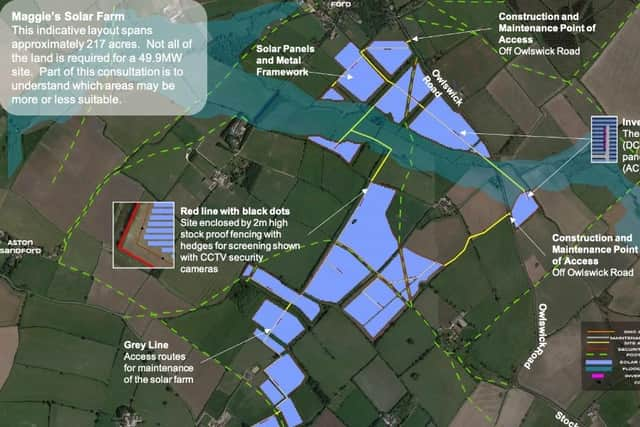Controversial solar farm the size of 77 football pitches approved in Aylesbury Vale village
and live on Freeview channel 276
Planners have approved a controversial solar farm the size of 77 football pitches in a Buckinghamshire village.
Measuring 62 hectares, ‘Callie’s Solar Farm’ will be built across 11 fields between Owlswick Road and the A4129 Thame Road, Ford.
Advertisement
Hide AdAdvertisement
Hide AdApplicant Low Carbon UK Solar Investment Company Limited was given permission for the new site on Monday (25 March).


The company plans to construct a 49.9 MW solar farm, remaining in place for 40 years from the date of the first exportation of electricity from the site.
The approved plans are very similar to a previous proposal to build a solar farm on the same site, which was refused in 2021.
That application planned the solar farm across 97 hectares of land, with solar panels 3m high, but was rejected by planners due to its impact on the landscape and risk to local habitats.
Advertisement
Hide AdAdvertisement
Hide AdThe applicant’s revised and approved plans for the solar farm state that sheep will graze under and around the solar panels and that there will be additional tree and hedgerow planting.
However, dozens of local people have objected to the plans, claiming that biodiversity will still be harmed, the landscape will be impacted, agricultural land will be lost and that the return of the site to its original use after 40 years has not been properly investigated.
Local Liberal Democrat councillor Sue Lewin argued that the newly-approved plans for the solar farm were nearly identical to the ones that were refused.
She wrote: “The reduction in area of land being used, whilst still having the same number of panels in total, indicates that the panels will be more closely packed in this revised proposal.
Advertisement
Hide AdAdvertisement
Hide Ad“This is therefore likely to make the solar farm more visible from the area of natural beauty as it will appear as a more solid mass of panels with less space between the rows of panels.”
Blueprints for the renewable energy site do not specify how many individual solar panels there will be.
However, the panels will be arranged in hundreds of ‘arrays’, which will be mounted on frames, pile driven into the ground, with a maximum height of 2.5 metres.
Two vehicular access points will be created from the A4129 and Owlswick Road, while internal tracks will also be laid.
Advertisement
Hide AdAdvertisement
Hide AdAn electricity substation, inverters and transformers, security fencing, CCTV cameras and other infrastructure will also be built as part of the site.
The applicant claims that the solar farm will help increase the UK’s renewable energy production and reduce emissions of CO2, a greenhouse gas, which contributes to climate change.
A handful of supporters of the plans agreed, noting that the ‘country is facing an energy crisis’ and should prioritise domestic energy production.
However, the Conservative MP for Buckingham Greg Smith argued that more solar panels should instead be fixed to rooftops as opposed to set into the countryside.
Advertisement
Hide AdAdvertisement
Hide AdObjecting to the plans, he also said: “I continue to highlight the issue of food security, which has been further by the war in Ukraine. Agricultural land regardless of quality should be safeguarded.”